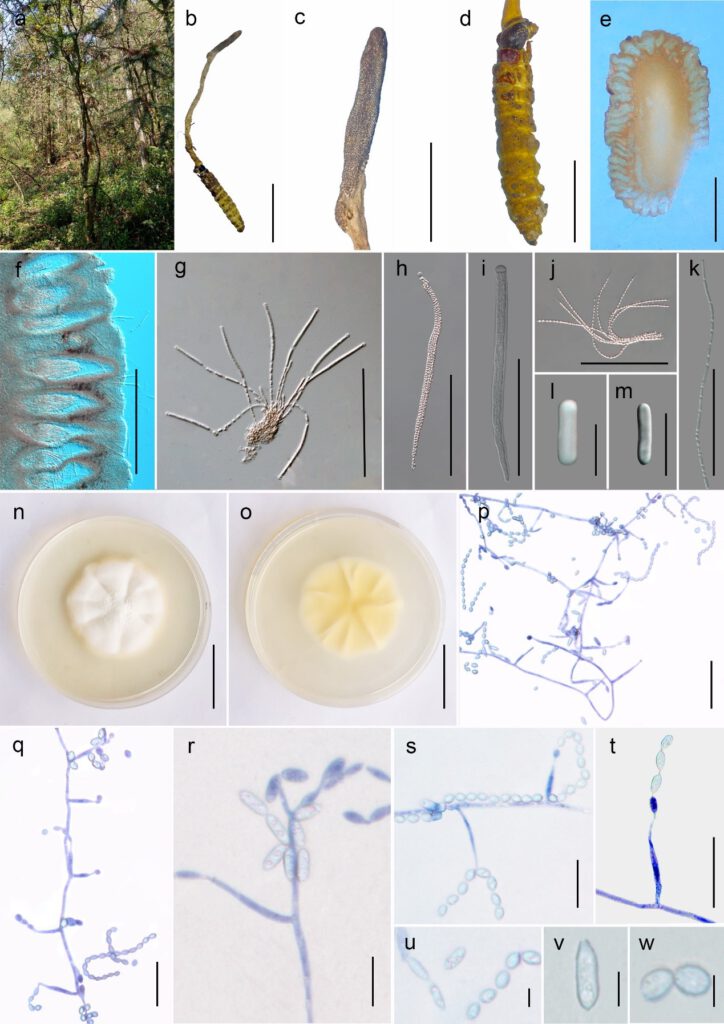Papiliomyces longiclavatum Y.Zhang, T.C. Wen & Y.P. Xiao
MycoBank number: MB 558796; Index Fungorum number: IF 558796; Facesoffungi number: FoF 10474;
Description
Sexual morph: Host, a bat moth larva, grayish white to light yellow, about 3.5-4.8 cm long. Stromata arising from the head of host, ovary, clavate, solitary, 4-6 cm long, 0.3-0.5 cm thick. Stipe cylindrical, grayish white to light yellow, fleshy, glabrous, enlarging abruptly at fertile portion. Fertile head length 1.5-2.1 cm, 0.4-0.6 cm thick, gray white to gray black, mature with a clear boundary with the stalk, no sterile tip. Ascomata, bottle shaped, buried, 320-580×110-230 um (=442×186 um, n=30). Asci, narrowly cylindrical, 8-spored, hyaline, possessing a prominent apical cap, 140-230×4.8-6.5 um (=183×5.8 um, n=30). Apical cap, 5.2-6.7 um (=5.8 um, n=30). Ascospores are nearly isometric, transparent and colorless, slender, filiform, smooth, mature and break into secondary ascospores. Secondary ascospores, 5.2-9.3×1.l-1.5 um(=6.8×1.3 um, n=30).Asexual morph: Colonies on Czapek agar, attaining a diameter of 2–3 cm within 14d at 25°C, dense, flat, velvety, white, the back was light yellow in the middle, and the edge was white. There are two types of phalides: α-phalides and β-phalides. α-phialides 12.6-23.8×1.4-2.4 um (=18.2×1.9 um, n=30), hyaline, smooth, solitary, mostly arising from aerial hyphae, shorter and gradually thinner upward. β-phalides 28.2-44.5×1.2-1.8 um (= 36.2×1.5 um, n=30), hyaline, smooth, slender, conical, mostly solitary. The diameter of α-conidia is 3.1-5.1×1.2-2.5 um (=4.5 um, n=30), round, single celled, smooth, colorless and transparent. The β-conidia are 5.8-9.9×1.3-2.7 um (=8.6×1.8 um, n=30), fusiform, with sharp ends, single cell and smooth wall.
Material examined: — CHINA. Guizhou Province: Guiyang, Yangchang, on lepidopteran larva, 14 June 2020, Yu Yang YC20064103 (GZUH YC20064103!), Yu Yang YC20064107 (HKAS 115914!), Yu Yang YC20064104 (GZUH YC20064104!), Yu Yang YC20064108 (GZUH YC20064108!); holotype, GZUH YC20064103; ex-type living culture HKAS 115914.
Distribution: Yangchang, Guiyang, Guizhou, Province, China.
Sequence data: ITS: MZ702080 (ITS4/ITS5); SSU: MZ702112 (NS1/NS4); LSU: MZ702101 (LROR/LR5); TEF1α: MZ955880 (EF1-2218R/EF1-883F); RPB1: MZ955876(RPB1Cr/CRPB1A) RPB2: MZ955872 (f-RPB2-5F/f-RPB2-7CR)
Notes: This species is closely related to Papiliomyces liangshanensis (Zang et al.1982) Luangsa-ard, Samson & Thanakitpipattana (Metacordyceps liangshanensis) and Papiliomyces shibinensis (Wen et al. 2015) Luangsa-ard Samson & Thanakitpipattana (Metacordyceps shibinensis) in the phylogenetic tree (Fig. 1). And compared with Papiliomyces liangshanensis, this species produces robust stroma with completely immersed perithecia and multi-septate, whole ascospores, but without a pregnant tip. This species has also two kinds of phalides(α-phalides and β-phalides) and two kinds of conidia (α-conidia and β- conidia) compared to the application of Papiliomyces shibinensis. The phylogenetic analysis does not have good support, but Papiliomyces longiclavatum is distinct from Papiliomyces liangshanensis and Papiliomyces shibinensis.

Fig. 1. Papiliomyces longiclavatum (neotype). a. Habitat. b. Overiew of the host and stromata. c. Stromata. d. Host. e. Vertical section of the stroma. f Section of ascomata. g-h. Immature to mature asci. i. Apical cap of asci. j-k Part of ascospores. l-m. Secondary ascospores. n. Upper side of the culture. o. Reverse side of the culture. p. mycelium. q.s.α-Phialides. r.t. β-Phialides. u. Two kinds of conidia. v. β-conidia. w. α- conidia. b=3 cm. c=1 cm. d=1 cm. e=0.1 cm. f=400 um. g=150um h=i=j=100um. k=50um. l=m=5um. n=o=1cm. p=30um. q=r=s=t=20um. u= v=w=5um.
